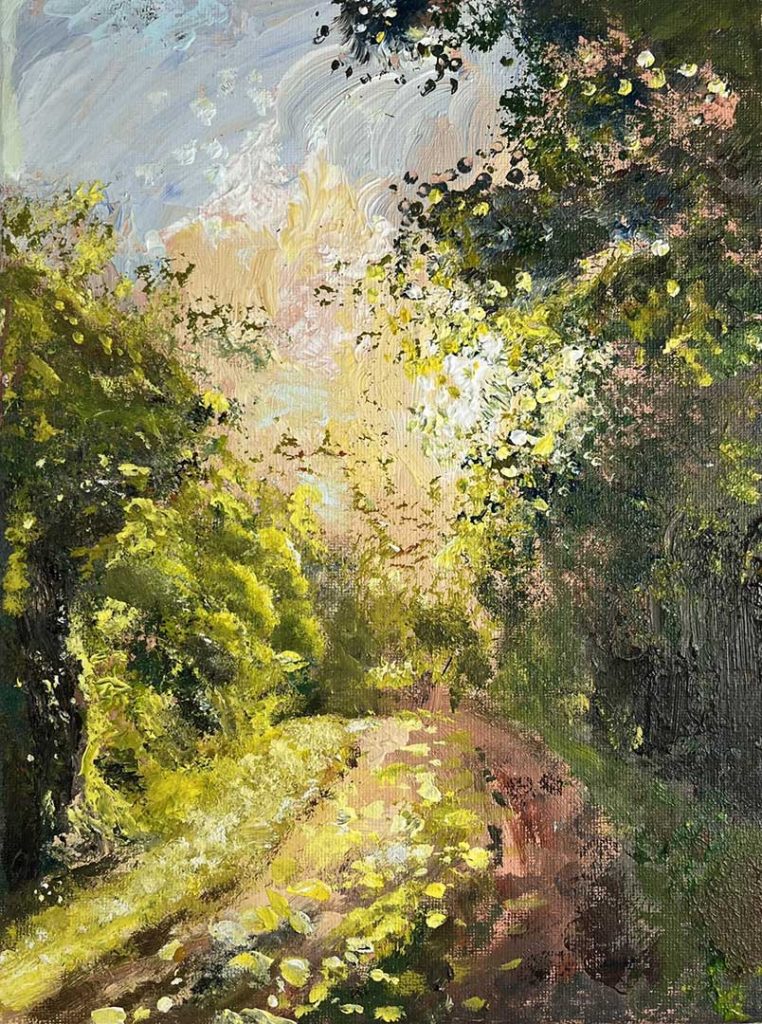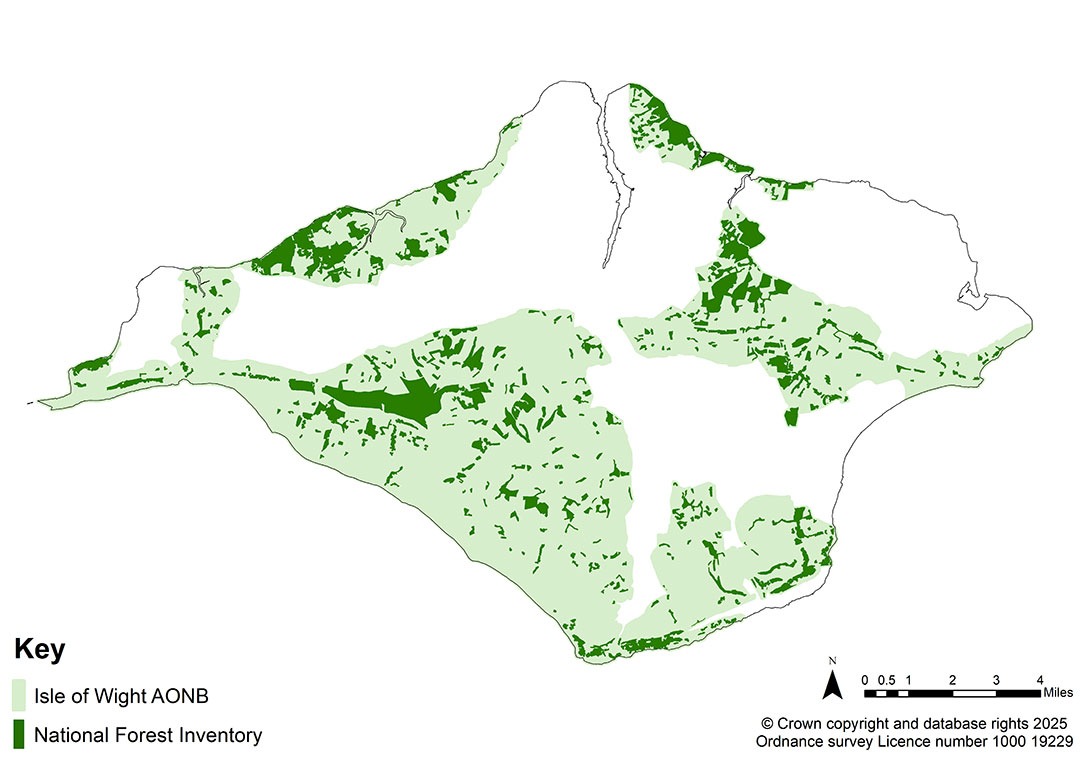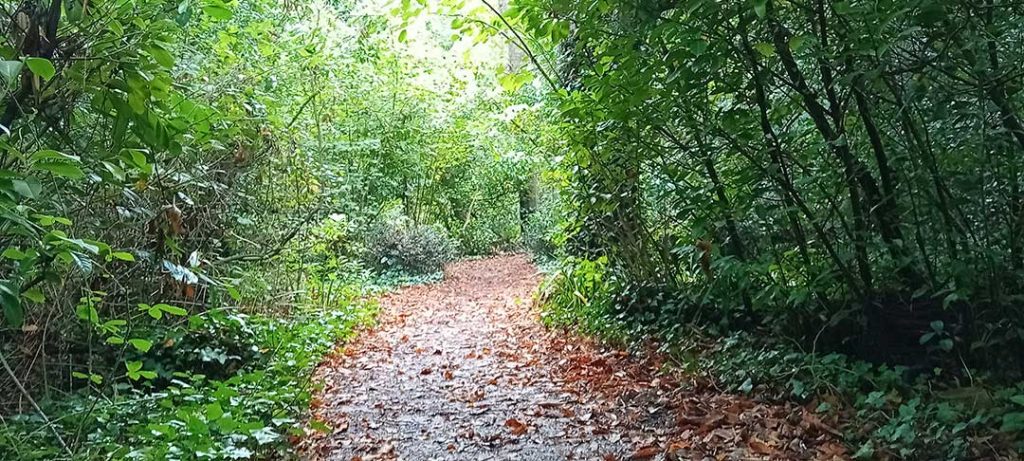On this page you will find:
- Forestry and Woodland Management Overview
- Key Facts and figures
- Sustaining the Landscape
- Management Influences and Forces for Change
- Policies and Priorities
Forestry and Woodland Management Overview
Woodland is an important component of the landscape of the AONB, covering 2778 ha (14.5%) of the designation, of which 644 ha is managed by the Forestry Commission. Whilst these include some plantation woodland, most are smaller broadleaved woods and copses. The majority of woodlands are located on wetter soils and are a dominant landscape feature north of the central chalk ridge. Where they do occur near the chalk downland or sandstone hills, they tend to be on steep slopes that are difficult to farm. Secondary woodland areas are also found in the Isle of Wight AONB where land has been unmanaged for many years and particularly on coastal slopes where many have become important landscape features.
Woodland in the Isle of Wight AONB is generally under-managed and timber production is a marginal activity. Amenity use and the wildlife value of woodland are of increasing importance, with some woodlands being managed by charitable organisations specifically for wildlife.
A significant proportion of the Isle of Wight AONB woodland is classified as Ancient Woodland. This means woodland has been present on that site since at least 1600AD, making them an important historic landscape feature and a reflection of the continuation of the value of woodland for people. They are also considered to be important for biodiversity. A number of these woodlands are referred to as Planted Ancient Woodland Sites (PAWS) where the woodland has been modified by the removal of native species and planted up with non-natives, usually conifers. The revised Isle of Wight provisional Ancient Woodland Inventory101, published in 2014, gives us an up to date understanding of the abundance and distribution of ancient woodland which contributes to the overall landscape character. Ancient woodland is considered an ‘irreplaceable’ habitat in the NPPF 202310 which confers protection in the planning system.
Veteran trees, wood pasture and parklands can be of great landscape, historic environment, and biodiversity value, and also require sympathetic and careful management.
The lack of influence of Grey Squirrel and feral deer, has a direct benefit for the woodland flora and fauna across the Island and in the Isle of Wight AONB.

Between 1996 and 2019 the amount of woodland on the Isle of Wight, increased to 13%102. Much of this increase was due to the Forestry Commission’s JIGSAW (Joining and Increasing Grant Scheme for Ancient Woodland) initiative funded by EU Challenge Funds.
Timber from plantation forestry under the control of the Forestry Commission has been largely exported to the mainland, with the contracts for this going to larger mainland companies. Through the development of a collaborative approach, local woodland contractors can now compete to work these woodlands. As a consequence of this woodland management linked to local fuel production has started to increase the viability of local woodlands. There is a need to provide necessary infrastructure and investment for enhanced wood fuel markets.
There are two medium sized active sawmills in operation on the Isle of Wight, but the local market remains small. Increasing regulation in response to a more litigious society is having an impact on these small businesses.
Key Facts and Figures
Map of Isle of Wight AONB Woodland

Sustaining the Landscape
Woodlands provide a range of ecosystem services these include timber, wood for fuel, wildlife habitats (including those for rare woodland species such as Red Squirrels, Hazel Dormouse, Barbastelle and Bechstein’s Bat), regulation of soil erosion, alleviation of flood risk and sequestration of carbon.
Well-sited trees and woods can:
- help prevent silts and nutrients from entering watercourses (both from agricultural land and sewage works where there may be potential to treat grey water by filtering through woodland);
- slow down flood flows across flood plains (which can be enhanced by using ‘woody debris’ dams to push flood flows onto wider floodplains);
- provide a valuable alternative land use which is not adversely affected by flooding (particularly if linked to local use of wood as a renewable fuel);
- maintain and improve fisheries by providing shade to reduce the temperature of water during summer months.
- provide the skeleton of a more resilient catchment landscape able to cope with the physical and ecological impacts of climate change; and
- help stabilise river channels, either directly via the growing trees, or indirectly by using the carbon lean woody material (e.g. faggots).
Woodlands also provide an important multifunctional recreational resource and have great cultural resonance with people.

Much of the management of woodland, outside Forestry Commission sites, is focussed on biodiversity as the value of the timber is low and transport is expensive. Undermanaged woodlands will have an impact upon elements of ground flora and invertebrate interest and will influence the availability of habitat for key species.
There is also a range of archaeological sites occurring within woodland. Some, such as Bronze Age burial mounds and prehistoric/Romano-British field systems pre-date the planting of woodland. Others, such as wood banks, saw pits or charcoal burning platforms are associated with woodland activities.
Management Influences and Forces for Change
The uptake of products from emerging wood fuel markets promotes the use of local wood products that are sustainably sourced, support woodland resilience and the local economy.
The prevalence of Ash-die back, Pine-needle blight, horse chestnut moth, Dutch elm disease and Phytophthora on oak and alder, with the threat of sweet chestnut blight will have a profound effect on the woodlands, wood pasture, hedgerows, and amenity trees in the Isle of Wight AONB. There is an increasing need for mixed and resilient species and varieties within woodlands to avoid significant landscape change through individual tree species loss as a result of pests and diseases. Resilience will be increased by species diversity as well as diversity of age structure produced by both natural regeneration and silvicultural management.
As part of the Environmental Improvement Plan 2022 the UK Government is committed to plant 34,000 ha of new woodland by 2028, relying on third parties to plant the great proportion of this woodland. Grants are available to plan and create new woodlands to UK Forestry Standards from the Forestry Commission to incentivise new woodland planting.
There is a need to consider the impact on the distribution of particular tree species in relation to a changing climate particularly when undertaking long term planting schemes.
There may be an increased incidence of forest fires due to the potential effects of climate change.
Any future changes to the Forestry Commission may result in changes from current approaches being taken by this national body.
Under-managed woodland areas can also experience inappropriate and damaging impacts from uncontrolled leisure activities (mountain biking, skateboard jumps) and fly tipping.

DEFRA Targets and Outcomes for Woodland
The Isle of Wight National Landscape team will be supporting and promoting the targets for woodland as laid out in the IWAOB Nature Recovery Plan as its contribution to the DEFRA Protected Landscapes Targets and Outcomes Framework.
Specific targets for woodland for the life of this Plan are shown below:
| Habitat | Maintain | Fav Condition | Restore/ create |
| Woodland | 471 | 352 | 400 |
Policies for Forestry and Woodland Management
These policies should be read in conjunction with the overarching objectives for the Isle of Wight AONB as detailed on the welcome and overview page – Isle of Wight National Landscape: Area of Outstanding Natural Beauty Management Plan 2025-2030 – Isle of Wight National Landscape.
P34 Encourage sustainable forestry, sympathetic woodland planting proposals, woodland management practices and the development of sustainable wood markets (fuel and other products) to deliver AONB objectives.
P35 Promote opportunities to deliver sustainable woodland management and promote the intrinsic relationship between woodland activities and the landscape of the Isle of Wight AONB.
Priorities for Delivery
- Promote and support the DEFRA Targets and Outcomes for the Isle of Wight National Landscape regarding woodland maintenance, restoration, and creation.
- Support activity that encourages the sustainability of local wood markets where this benefits woodland management for landscape and biodiversity.
- Support the establishment of new native woodlands in appropriate sites which can contribute to climate change mitigation through carbon sequestration.